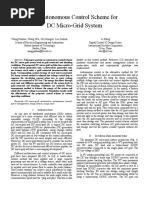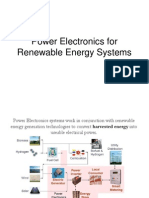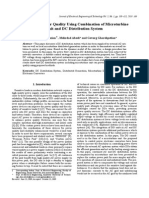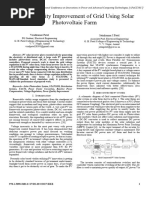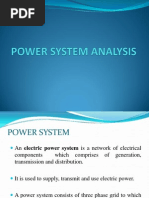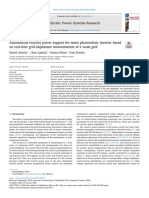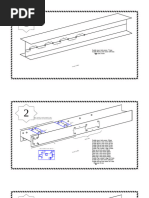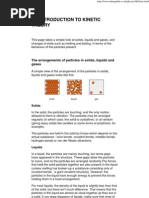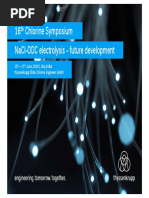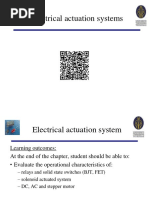Control of PV Array Based Distributed Generator
Control of PV Array Based Distributed Generator
Uploaded by
Shareef KhanCopyright:
Available Formats
Control of PV Array Based Distributed Generator
Control of PV Array Based Distributed Generator
Uploaded by
Shareef KhanOriginal Description:
Copyright
Available Formats
Share this document
Did you find this document useful?
Is this content inappropriate?
Copyright:
Available Formats
Control of PV Array Based Distributed Generator
Control of PV Array Based Distributed Generator
Uploaded by
Shareef KhanCopyright:
Available Formats
Control of PV Array Based Distributed Generator For Loss Minimization:
M.N.V.L. Bharath B.TECH, E.E.E, V.R.Siddhartha Engineering College, Vijayawada-520007. naga_mandava007@yahoo.com Abstract: Power distribution system in the country is characterized by high power losses, poor reliability of supply, frequent equipment attributed to poor planning and low operational efficiency of the distribution network. Distribution generation provides electric power at a site closer to the customer, eliminating the unnecessary transmission and distribution costs. Interfacing of solar PV array to the grid or distribution network has been considered as a feasible option for reducing the losses and meeting the increasing demand on a distributed network. In this context power integral and average current mod controllers have been proposed in this paper, for the pulse width modulated voltage source inverter employed for the integrating the PV array to the distribution network. The proposed controllers have been designed and simulated using power system block set of the MATLAB software. Simulation results confirm that the developed controllers can be successfully employed to vary real and reactive power of the Inverter. Introduction: Solar Energy is also having distributed generation potential. Distribution Generation is defined as the generation of energy closer to the point of use. Distribution Generation ranges typically ranges from 1kW to 5MW in capacity. This contrast with Central Generation, which associated with large 500 to 3000MW generating plants that are usually located at a distance from where the energy is consumed. The electricity transported through the transmission and distribution infrastructure to the consumer. Electric utilities have hysterically satisfied customer demand by generating electrically and distributing it through an extensive transmission and distribution network. As demand increases, the utility generates more electrically. Once demand increases beyond a certain level, the capacity of generation, transmission and distribution system become constrained. The traditional utility response to these constraints is to build new facilities. Kiran Jasthi B.TECH, E.E.E, V.R.Siddhartha Engineering College Vijayawada-520007 kiran_jasthi87@yahoo.co.in
An alternative approach under consideration by utilities is to satisfy demand locally and incrementally by investigating distributed generation. Distributed generation facilitates are strategically sited to deliver electricity where it needed. This can relive capacity constraints on the generation, transmission, and distribution systems and obviate the need to build new facilities and can be configured to meet peak loads.
PV Grid interface: Gridconnected PV systems offer the opportunity to generate significant quantities of high-grade energy near the consumption point, avoiding transmission and distribution losses. These systems operate in parallel with existing electricity grids, allowing exchange of electricity to and from the grid. Building integration adds some advantages to grid connected PV systems. The most important is the cost displacement gained by integrating PV materials into the fabric of buildings, especially into commercial buildings with expensive cladding. It could as well give some extraeconomical motivations to people to invest in this new technology. Building integrated systems are expected to be the first cost effective application of Grid Connected PV in the developed world and will become a small, but important source of electricity generation in the next century. The world market for grid- connected photovoltaic systems is growing rapidly. Design Options: The basic Grid connected PV system design has as shown in fig
1. PV Array or Generator: A number of PV panels connected in series and/or in parallel giving a DC output of the incident irradiance. Orientation and tilt of these panels are important design parameters, as well as shading from surrounding obstructions.
2. Inverter: A power converter that inverts the DC power from the panels into AC power. The characteristics of the output signal should match the voltage, frequency and power quality limits in the supply network. In converting power between the two forms, the AC side is often, a voltage source provided by the power utility, a motor/generator or stand-alone inverters where the AC side voltage is the load voltage with a voltage supporting capacitance. The DC side voltage is generally power source or a power sink. The power flow between the DC voltage source and AC voltage source can be controlled via voltage phase & amplitude control and current control. For utility interactive PV applications, the voltage on the output is generally dictated by the utility/grid power source, therefore current control is used to output a predetermined power level. This task can be done using current controllers to output switching patterns in order to get the desired current wave shape at the inverter terminals. This concept leads to the development of a current controller for the PV grid interface Three-Phase Current Controlled VSI: In single-phase case for grid-connected PV systems VSI will be preferred one and also current control is suitable. Since the voltage on utility is stiff at the switching frequency, power flow can be controlled by directly controlling real and reactive component of the current. Unity power factor operation is achieved by forcing the respective AC phase voltage waveform. And also lagging and leading output currents can be achieved by approximately modifying the reference currents. In a CC (current control)-VSI, the switching instances are chosen by current regulators, which do not need an immediate regard for the average values of the voltages, which might be produced at the switch mid points.
3. Load: Stands for the network connected applications in the building that are fed from the inverter, or, alternatively, from the grid. 4. Meters: They account for the energy being drawn from the or fed into the local supply network.
5. Local Supply Network: A single or three-phase network managed by Public Electricity Supplier. The supply network acts both as a sink for energy surplus in the building or as a backup for low local generation periods. The overall efficiency of the system depends on the efficiencies of the SUNLIGHT into DC and the DC into AC. The first one varies up to 3% over a year. The second one, instead, shows a much greater variability. The efficiency of the inverter varies with load level. Although this relation is different for each inverter, a conventional model has a load/ efficiency curve similar to fig shown
Therefore, a key consideration in the design and operation of inverters is how to achieve high efficiency with varying power output. It is necessary to maintain the inverter at or near full load in order operate in the high efficiency region. However, this is not possible. Some installations would never reach their rated power due to deficient tilt, orientation or irradiation in the region. Basic Schematic Diagram of Control Circuit: The effect of PV source on the distribution network is studied by considering the following parameters of the distribution line 1. Voltage on the distribution line 2. Power loss 3. Load absorbed power
Basic control schematic is shown in the fig. Main is the feeding power to the unbalanced power system which consists of star /star connected transformer. So the load is facing unbalanced
power supply. By using three-phase inverter fed by PV array is connected towards the load side. The inverter consists of six IGBTs connected as shown in fig. The inverter converts feeded DC power in to AC power depending on the transformer turns ratio. The losses are being compensated by the power fed by the PV array based distributed generation. The losses are in the range of few kilo watts depend on the load resistances. Development of the CC Power Conditioning System: In the development of this power conditioning system, we sought superior accuracy in current control so as to eliminate any low-order current harmonics, which may be generated by the converter. Further more, we sought sufficiently high real power control bandwidth so as to minimize the energy storage required in the dc link. This energy storage is provided by the dc-link capacitance, which also serves as a filter for the side switching frequency ripple current. A power flow control bandwidth of a few milliseconds was sought which would mean that the dc-link capacitance could be chosen solely to meet the ripple current requirements. Inherent Over Current Protection: CC offers inherent over current protection. The only circumstances where the current may exceed the maximum reference value is when something fails, or if Controllability is lost due to a collapse of the dc-link voltage. The high bandwidth of control ensures that this collapse will not happen. CC has inherent soft start capabilities since the current reference magnitude can be ramped up at any desired rate. No DC or Zero Sequence Currents: Since the inductance has very small impedance at low frequencies or dc, any imbalances in the three-phase PWM voltage under PAC could result in significant dc or zero sequence currents. The equivalent diagram corresponding to the power flow is shown. Under CC; these undesirable currents will not be present. The power current forced to follow a reference waveform, which is devoid of significant dc offsets
Power Conditioning System: The power conditioning system provides up to 30kVA of reactive power, and up to 20 kW of real power from the photovoltaic array. The block diagram for conditioning
is shown below. This system is designed to upgrade to 75kVA. Two outer control loops operate to independently control the real and reactive power flow in the converter.
Real Power Control: Real power through the converter is controlled through the dc-link voltage regulation. The dc-link voltage is maintained at a reference value by a PI control loop, which gives the real current reference magnitude as its output. The reference voltage for the dc link is determined by the supervisory real power controller, which uses a true maximum power point (MPP) tracking algorithm to maximize the power output from the PV array.
Above fig shows the typical output characteristics of a solar panel. The MPP is located at the knee of the V-I curve and is a function of the cell temperature and the radiation level. To maintain operation at the correct MPP voltage, the reference dc-link voltage is continuously shifted in small increments. After a shift in one direction, the resultant change in power is measured from the dc voltage and current. If the power has increased then another shift is applied in the same direction. If the power has decreased then the direction of the shift is reversed. In this way, the dc-link voltage is always shifted toward a point of maximum dc power. Line Voltage control: The reactive power from the power conditioning system is used to regulate the line voltage site. The effect of the reactive power through the site 415-6.6kV-transformer impedance produces a voltage shift between the local voltage and the voltage upstream. The control system has a simple transfer function, which varies the reactive power command in response to ac voltage fluctuations. The rate of change is controlled to coordinate with the line tap changer located upstream. From 22:00-0:15 h, the line voltage is UN controlled, and is continuously varying. When the reactive power control comes into effect, the voltage is held constant through the reactive power control.
Simulation: The solar panel gives the simulation results corresponding to the control of PV array based distribution generation. In order to simulate the current controlled PV fed three phase inverter with employed transmission line to PSB the simulation block diagram is shown with and with out transmission line losses.
Simulation results are: R r 5 1 0 3 0 3 5 4 Ry Rb Ir 10 20 40 45 50 15 30 50 55 60 13. 9 10. 5 5.3 4.7 4.2 Iy 10. 5 7.1 4.2 3.9 3.5 Ib 8. 5 5. 3 3. 5 3. 3 3. In 8. 3 8. 3 8. 3 8. 3 8. Vry 69.0 105. 6 166. 6 171. 5 178. Vyb 105. 6 142. 2 168. 4 169. 3 171. Vbr 127.6 160.33 179.4 181.5 184.0
0 0 3 5 5 Control of PV array without transmission line losses R r 5 1 0 3 0 Ry Rb Ir 10 20 40 15 30 50 13. 9 10. 5 5.3 Iy 10. 5 7.1 4.2 Ib 8. 5 5. 3 3. 5 In 8. 3 8. 3 8. 3 Vry 69.0 105. 6 166. 6 Vyb 105. 6 142. 2 168. 4 Vbr 127.6 160.33 179.4
3 5 4
45 50
55 60
4.7 4.2
3.9 3.5
3. 3 3.
8. 3 8.
171. 5 178.
169. 3 171.
181.5 184.0
0 0 3 5 5 Control of PV array with transmission line losses Advantages: 1. it can reduce or avoid the necessity to build new transmission/distribution lines or upgrade existing ones 2. It can be configured to meet peak power needs 3. It can diversify the range of energy sources in use and increase the reliability of the grid network 4. It can be configured to provide premium power, when coupled with uninterruptible power supply (UPS) 5. It is well suited to the use of some renewable energy technologies, because they can be located close to the user and can be installed in small increments to match the load requirement of the customer The future of distributed PV: The entire field of distributed generation is undergoing a significant evolution that will affect the development of PV. Net metering programs in many states allow owners of distributed generation to feed excess electricity to the grid, in effect using it as a free and 100 % efficient storage battery. This latter development is particularly important for distributed PV. In some cases, the ability to store energy on the grid for later use can eliminate the need for large and expensive energy storage systems such as batteries. One of the primary batteries to widespread use of rooftop and building integrated PV is simple unfamiliarity. Developers dont plan for it, architects dont include it in their designs and construction, and contractors havent learned how to install and integrate it with standard wiring and metering schemes, and customers dont think to demand it. As more PV is put into service, familiarity and demand will increase. As PV is attractively or even invisibly incorporated into building materials, builders will design projects to accommodate it. Bibliography: 1] Tom Hoff and Daniel S.Shugar, the value of grid support photo voltaics in reducing distribution system losses, IEEE transactions on energy conversion in 1995. 2] Tom Hoff, Howard J. Wenger, and Brian K. Farmer, The value of grid support photo voltaics in providing distribution system voltage support, proceedings of the 1994 American solar energy society annual conference, San Jose, California, June 1994.
3] Rick Lambeth and Tom Lepley, distributed photo voltaic system evaluation by Arizona public service company, proceedings of the 23rd IEEE PV specialists conference, Louisville, Kentucky, may 1993. 4] Thomas E.Hoff and Howard J.Wenger, The value of Photovoitaics in the distribution system: The Kerman Grid support project, Pacific gas and Electric Company report, 1995. 5] www.actapress.com 6] www.greenenergyohio.org 7] www.energychallenge.org 8] www.progress-energy.com
You might also like
- 1Document38 pages1Monika GNo ratings yet
- An Efficient Constant Current Controller For PV Solar Power Generator Integrated With The GridDocument6 pagesAn Efficient Constant Current Controller For PV Solar Power Generator Integrated With The GridsunilkumareceNo ratings yet
- Bi-Directional AC-DC/DC-AC Converter For Power Sharing of Hybrid AC/DC SystemsDocument8 pagesBi-Directional AC-DC/DC-AC Converter For Power Sharing of Hybrid AC/DC SystemsJitender KaushalNo ratings yet
- 1 PDFDocument4 pages1 PDFMohan KrishnaNo ratings yet
- Ancillary Services and Stability Analysis of Distributed Generation SystemDocument5 pagesAncillary Services and Stability Analysis of Distributed Generation SystemShakeel RanaNo ratings yet
- GridDocument6 pagesGridgiongan342No ratings yet
- Grid Integration Issues On Power SystemDocument20 pagesGrid Integration Issues On Power Systemsoumen gorai100% (3)
- Base PaperDocument5 pagesBase PaperVinay BhardwajNo ratings yet
- Design of PV System With Double Boost ConverterDocument53 pagesDesign of PV System With Double Boost ConverterBalamurugan100% (1)
- Advancements in Inverter TechnologyDocument27 pagesAdvancements in Inverter TechnologyAbhishek KumarNo ratings yet
- Grid Impact Study - Omazaki GroupDocument10 pagesGrid Impact Study - Omazaki GroupHafiz Bilal AhmadNo ratings yet
- Reactive Power Compensation in PV Inverters (AutoRecovered)Document15 pagesReactive Power Compensation in PV Inverters (AutoRecovered)varshaNo ratings yet
- Connection of Converters To A Low and Medium Power DC Network Using An Inductor CircuitDocument3 pagesConnection of Converters To A Low and Medium Power DC Network Using An Inductor Circuitnklharish1No ratings yet
- Controllable Network Transformers: Deepak Divan and Jyoti SastryDocument6 pagesControllable Network Transformers: Deepak Divan and Jyoti SastryimdadamuNo ratings yet
- Power Electronics For SolarDocument9 pagesPower Electronics For SolarbalafetNo ratings yet
- Power Electronics For Renewable Energy SystemsDocument33 pagesPower Electronics For Renewable Energy SystemssrilakshmisiriNo ratings yet
- Flexible AC Transmission SystemsDocument51 pagesFlexible AC Transmission SystemsPriyanka VedulaNo ratings yet
- Power Control of DC Microgrid With Variable Generation and Energy StorageDocument5 pagesPower Control of DC Microgrid With Variable Generation and Energy StorageSEP-PublisherNo ratings yet
- Premium Power Quality Using Combination of Microturbine Unit and DC Distribution SystemDocument13 pagesPremium Power Quality Using Combination of Microturbine Unit and DC Distribution SystemSandeep RaiNo ratings yet
- CapDocument8 pagesCapkavinsmartNo ratings yet
- Dstatcom BessDocument7 pagesDstatcom BessSYAHRUN MUBAROKNo ratings yet
- Grid Connected Battery SystemDocument34 pagesGrid Connected Battery SystemmygodspNo ratings yet
- Power Quality Improvement of Grid Using Solar Photovoltaic FarmDocument6 pagesPower Quality Improvement of Grid Using Solar Photovoltaic Farm2021809568No ratings yet
- Enhancement of Power Quality in Grid Connected Wind Energy System Using STATCOMDocument9 pagesEnhancement of Power Quality in Grid Connected Wind Energy System Using STATCOMShaik Muhammad ImranNo ratings yet
- Multilevel LVDC Distribution System With Voltage Unbalancing and Disturbance Rejection Control TopologyDocument15 pagesMultilevel LVDC Distribution System With Voltage Unbalancing and Disturbance Rejection Control TopologyNexgen TechnologyNo ratings yet
- Closed Loop Control of Grid Connected PV InverterDocument33 pagesClosed Loop Control of Grid Connected PV InverterWA Q AS100% (1)
- Final Year Project Report Chapter 1,2Document13 pagesFinal Year Project Report Chapter 1,2Dhanush NNo ratings yet
- Mohammedsaeed 2017Document6 pagesMohammedsaeed 2017joaoNo ratings yet
- Reactive Power FundamDocument24 pagesReactive Power FundamNaveedNo ratings yet
- A Novel IntegratedDocument2 pagesA Novel IntegratedshanofaNo ratings yet
- Power Factor Improvement by Pulse Width Modulated Switched Single CapacitorDocument4 pagesPower Factor Improvement by Pulse Width Modulated Switched Single CapacitorLuqman SolihinNo ratings yet
- Enhancing stability and voltage quality in remote DC microgrid systems through adaptive droop control approachDocument12 pagesEnhancing stability and voltage quality in remote DC microgrid systems through adaptive droop control approachInternational Journal of Power Electronics and Drive SystemsNo ratings yet
- Module 4Document9 pagesModule 4Dheeraj GmNo ratings yet
- Power System AnalysisDocument47 pagesPower System AnalysisManirajPerumalNo ratings yet
- 1advanced Controller Design For D-FACTS Device in Grid Connected PV System - EditedDocument6 pages1advanced Controller Design For D-FACTS Device in Grid Connected PV System - EditedBrian BlazerNo ratings yet
- Optimized Bidirectional Power Flow Control in GridDocument16 pagesOptimized Bidirectional Power Flow Control in GridRajesh DommetiNo ratings yet
- LVDC DocumentDocument25 pagesLVDC DocumentNexgen TechnologyNo ratings yet
- Ieee Transactions On Smart Grid, Vol. 8, No. 2, March 2017Document6 pagesIeee Transactions On Smart Grid, Vol. 8, No. 2, March 2017yugeswarNo ratings yet
- Power Quality Improvement of Distribution System Using D-STATCOMDocument11 pagesPower Quality Improvement of Distribution System Using D-STATCOMShashankNo ratings yet
- Energies 16 03245Document20 pagesEnergies 16 03245khannoussi kamiliaNo ratings yet
- AC EditedDocument22 pagesAC EditedEmmanuel Ayodele DavidNo ratings yet
- Unit - 4 - Power Electronics and Energy Storage in Smart GridDocument50 pagesUnit - 4 - Power Electronics and Energy Storage in Smart GridsujithNo ratings yet
- A Grid Tied SPV System With Adaptive DC Link Voltage For CPI Voltage Variations Using Fuzzy Logic ControlDocument9 pagesA Grid Tied SPV System With Adaptive DC Link Voltage For CPI Voltage Variations Using Fuzzy Logic ControlAbhinav ShendageNo ratings yet
- Electric Power Systems Research: SciencedirectDocument14 pagesElectric Power Systems Research: Sciencedirectoscard1ofNo ratings yet
- Chapters 3Document54 pagesChapters 3Jspmani2040No ratings yet
- Optimal Integration of An Offshore Wind Farm To A Weak AC GridDocument8 pagesOptimal Integration of An Offshore Wind Farm To A Weak AC GridMadhusudhan SrinivasanNo ratings yet
- IJRPR2061Document6 pagesIJRPR2061jianggutou1999No ratings yet
- Stability Improvement of Microgrids Using A Novel Reduced UPFC Structure Via Nonlinear Optimal ControlDocument7 pagesStability Improvement of Microgrids Using A Novel Reduced UPFC Structure Via Nonlinear Optimal ControlEngr GM SialNo ratings yet
- Session 5Document64 pagesSession 5karen dejoNo ratings yet
- Power Quality Stabilization System For Grid Connected Large-Scale Solar Power SystemDocument12 pagesPower Quality Stabilization System For Grid Connected Large-Scale Solar Power SystemInternational Journal of Power Electronics and Drive SystemsNo ratings yet
- Design and Implementation of A Switching Converters Based Power System For Regions Victim To Frequent Power OutageDocument6 pagesDesign and Implementation of A Switching Converters Based Power System For Regions Victim To Frequent Power OutageAlexis CorzoNo ratings yet
- Voltage Vs Var Control Small Hydro IDocument10 pagesVoltage Vs Var Control Small Hydro Ikcirrenwod100% (1)
- Investigation of PV BalancersDocument6 pagesInvestigation of PV BalancersUday Kiran DokalaNo ratings yet
- Raviraju Published PaperDocument10 pagesRaviraju Published Paperraviraju2498No ratings yet
- Document For A Three Phase SPV SystsemDocument49 pagesDocument For A Three Phase SPV SystsemBhuviNo ratings yet
- Static Var CompensatorDocument55 pagesStatic Var CompensatorSuresh Nagulavancha50% (2)
- Methods for Increasing the Quality and Reliability of Power System Using FACTS DevicesFrom EverandMethods for Increasing the Quality and Reliability of Power System Using FACTS DevicesNo ratings yet
- Gudder DesignDocument26 pagesGudder DesignShareef KhanNo ratings yet
- Assistant Engineer Operation Section KrishnagiriDocument3 pagesAssistant Engineer Operation Section KrishnagiriShareef KhanNo ratings yet
- Operation and Maintenance of A Substation-Libre PDFDocument60 pagesOperation and Maintenance of A Substation-Libre PDFShareef KhanNo ratings yet
- Sharif ExpnDocument26 pagesSharif ExpnShareef KhanNo ratings yet
- Vtiger Developer Recruitment (Round 1 Test For Freshers) November 22, 2014 From 11:00 AM To 12:30 PMDocument1 pageVtiger Developer Recruitment (Round 1 Test For Freshers) November 22, 2014 From 11:00 AM To 12:30 PMShareef KhanNo ratings yet
- 22.design and Implementation of A Shunt Active Power Filter With Reduced DC Link VoltageDocument9 pages22.design and Implementation of A Shunt Active Power Filter With Reduced DC Link VoltageShareef KhanNo ratings yet
- PPDocument5 pagesPPShareef KhanNo ratings yet
- 9.a Modular Fuel Cell, Modular DC DC ConverterDocument62 pages9.a Modular Fuel Cell, Modular DC DC ConverterShareef KhanNo ratings yet
- Fuel+Table+ +Motor+GradersDocument2 pagesFuel+Table+ +Motor+GradersHopper GrassNo ratings yet
- Chapter 39 - More About Matter WavesDocument10 pagesChapter 39 - More About Matter WavesVV Cephei100% (2)
- IS0012 UDocument3 pagesIS0012 ULeigh GallowayNo ratings yet
- Pipe LectureDocument4 pagesPipe Lectureraymonddebelen20No ratings yet
- Laboratory Manual: University of Technology-Iraq Electrical Engineering Department-BSC CourseDocument18 pagesLaboratory Manual: University of Technology-Iraq Electrical Engineering Department-BSC CourseAlfnan AlfnanNo ratings yet
- Dynamic Models of Wind Turbines Thesis PerdanaDocument211 pagesDynamic Models of Wind Turbines Thesis PerdanalijiexautNo ratings yet
- Proposal Pendanaan IBE KSO FUNDER - 5M For Prod Cap.37,500mt Coal ROM - XCMG Rent OTBDocument2 pagesProposal Pendanaan IBE KSO FUNDER - 5M For Prod Cap.37,500mt Coal ROM - XCMG Rent OTBmantoNo ratings yet
- 0116 - 2023 LG Multi v Catalogue - 합본Document159 pages0116 - 2023 LG Multi v Catalogue - 합본Fabian Araya0% (1)
- ECE 3101 Industrial Electronics: Chopper DrivesDocument17 pagesECE 3101 Industrial Electronics: Chopper Drives17031 Nazmul HasanNo ratings yet
- Cooling: Air Conditioning Pack (21-51-00) Aircraft Maintenance Manual System Description SectionDocument7 pagesCooling: Air Conditioning Pack (21-51-00) Aircraft Maintenance Manual System Description Sectionnishat529No ratings yet
- SBM ReportDocument12 pagesSBM ReportWaiNo ratings yet
- RCD ProtectionDocument61 pagesRCD ProtectionKostas Papadimos100% (2)
- Product Data Sheet: Circuit Breaker Compact NS100N - TMD - 100 A - 4 Poles 4dDocument3 pagesProduct Data Sheet: Circuit Breaker Compact NS100N - TMD - 100 A - 4 Poles 4dGloria Cuero GonzalezNo ratings yet
- Week 4 - Actual Rankine CycleDocument13 pagesWeek 4 - Actual Rankine CycleLester Jave HechanovaNo ratings yet
- Eoc 1 Sesi 1 2021-2022Document3 pagesEoc 1 Sesi 1 2021-2022Muhammad Naim bin IshakNo ratings yet
- P4gravitation 2016Document71 pagesP4gravitation 2016Abdur RehmanNo ratings yet
- Heat QuizDocument3 pagesHeat QuizI Putu Yoga Widi LaksanaNo ratings yet
- Type P8n, PQ8n, PN8n: Auxiliary RelayDocument7 pagesType P8n, PQ8n, PN8n: Auxiliary RelayDinesh ThevanNo ratings yet
- Sunvention Sunpulse Water: Solar Thermal Water PumpDocument2 pagesSunvention Sunpulse Water: Solar Thermal Water Pumpagbuc11No ratings yet
- Relays: RJ Series - General Purpose RelaysDocument3 pagesRelays: RJ Series - General Purpose RelaysbansalrNo ratings yet
- Axpert VM IV - Ficha TécnicaDocument1 pageAxpert VM IV - Ficha TécnicaTariqMahmoodNo ratings yet
- Kinetic Theory - An IntroductionDocument5 pagesKinetic Theory - An IntroductionRaghavendra Nallan ChakravarthulaNo ratings yet
- PDD Roura PDFDocument57 pagesPDD Roura PDFChakradhar BabuNo ratings yet
- Boiler Erection FinalDocument51 pagesBoiler Erection FinalArul Aron Jose100% (1)
- 09 - B NaCl-ODC Electrolysis Technology - Future Development - Jörg KolbeDocument15 pages09 - B NaCl-ODC Electrolysis Technology - Future Development - Jörg KolbeAnburaj NatarajaNo ratings yet
- Gujarat Technological University: Project Report ON Scope of Utility Reduction in Chemical IndustryDocument24 pagesGujarat Technological University: Project Report ON Scope of Utility Reduction in Chemical IndustryPradeep SutharNo ratings yet
- Diesel Generator Set Qsg12 Series Engine: 400 Kva - 450 Kva 50 HZ 320 Kwe-400 Kwe 60 HZDocument4 pagesDiesel Generator Set Qsg12 Series Engine: 400 Kva - 450 Kva 50 HZ 320 Kwe-400 Kwe 60 HZFabian David EspitiaNo ratings yet
- Unit-Iii: B.E. 7 Semester (EEE) Re Class Test-I (2015-16) Subject-Electrical DrivesDocument1 pageUnit-Iii: B.E. 7 Semester (EEE) Re Class Test-I (2015-16) Subject-Electrical DrivesDavid StuartNo ratings yet
- 6 Electrical ActuatorsDocument27 pages6 Electrical ActuatorsKennie RajNo ratings yet
- 6SL3210-5BE21-5UV0 Datasheet enDocument2 pages6SL3210-5BE21-5UV0 Datasheet enshreyas sunejaNo ratings yet







